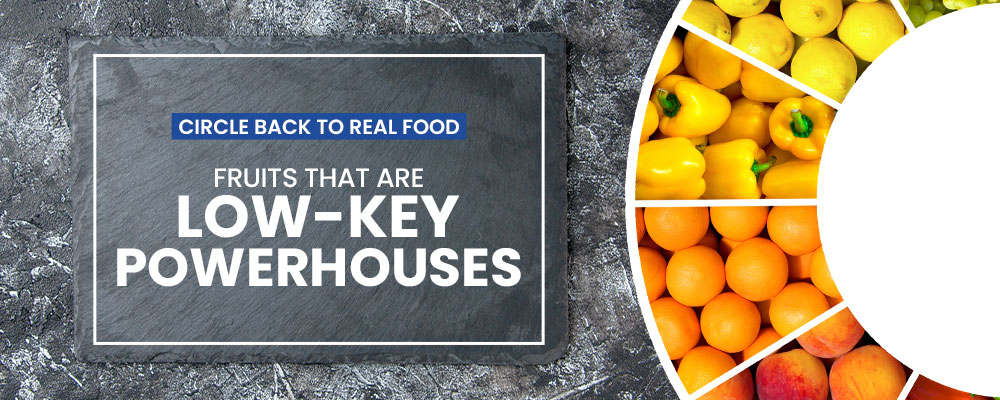Circle Back to Real Food: Fruits That Are Low-Key Powerhouses

“So, no one's gonna talk about how we’ve been sleeping on these fruits?”
Okay, let’s have a little reality check. We’ve been caught up in all these aesthetic bowls, spirulina powders, liquid chlorophyll trends, and “what I eat in a day” reels — but like…when was the last time you actually looked at the fruit section in your grocery store beyond bananas and berries?
Let’s break it down: some fruits are low-key nutritional gems, and they’ve been sitting quietly in the corner while we chase collagen gummies and overpriced superfood shots.
So here’s a scroll-stopper breakdown of underrated fruits you’re probably skipping — and why it’s time to circle back to a balanced diet (yes, we’re ditching the yo-yo fads). This isn't nutrition advice, just an honest look at some fruit facts and trends, backed by what’s commonly known and shared across reputable sources and wellness spaces.
1. Papaya — Your Gut’s New Bestie
Hear me out: this fruit is often said to support digestion and gets way less attention than it deserves.
It’s known to be a source of:
Papain (an enzyme linked to breaking down proteins)
Vitamin C (linked to skin health and immune support)
Fiber (something most of us don’t get enough of)
Some find it helpful for bloating or post-meal comfort. A daily slice might just be your new low-effort habit. And somehow...we're all reaching for "gut health greens powders"? Make it make sense.
Also: lesser-known types like Hawaiian Solo or Red Lady are smaller and often sweeter than the usual supermarket papaya. Easy to add to bowls or even just chill and eat as-is.
2. Passion Fruit — The High-Fiber Queen

This tiny fruit might surprise you: a single one can reportedly give you about 2 grams of fiber.
It’s also commonly noted for:
Having antioxidant properties
Being on the low end of the glycemic index
Containing Vitamin A and C
Its tart, tropical flavor makes it perfect over yogurt, chia pudding, or eaten straight. If you haven’t tried the yellow passion fruit or banana passion fruit, look out for them — they have different flavor tones and are popular in South American and Asian food cultures.
3. Jackfruit — Not Just a Vegan Meat Swap
Jackfruit isn’t just for meatless pulled pork. It’s a whole fruit with different varieties used across South and Southeast Asia.
Often mentioned as a good plant-based source of potassium
Naturally contains fiber and is low in fat
Ripe versions are sweet and dessert-like
There's the firmer, cooking-type jackfruit and the honey jack, which you can eat raw. The latter has a toffee-banana vibe and works well in smoothies or oats. While not exactly a protein powerhouse, it’s super filling and very versatile.
4. Camu Camu — The Hidden Vitamin C Bomb
This fruit may not be common on shelves, but it’s often highlighted in wellness circles for its vitamin C content.
Just a teaspoon of camu camu powder is reported to offer several times more Vitamin C than an orange
The fruit is native to the Amazon region and traditionally used in juices and jams
It’s available in freeze-dried, powdered, or juice form, usually from specialty or Latin American markets. It's a fun, tangy add-in if you're into experimenting with smoothie ingredients.
5. Loquat — The Soft, Juicy Underdog
You’ve probably seen this one without realizing it — tiny, orange, peach-looking fruit that’s popular in East Asian and Mediterranean cultures.
Known to contain Vitamin A, potassium, and fiber
Has a mild mango-apricot taste
There are white-fleshed and orange-fleshed types. The white ones are sweeter, while orange ones lean tangier. These show up in foraging circles and backyard harvests on TikTok — and honestly, it’s a flavor you don’t forget.
Why This Matters: You’re Not “Missing Out” — You’re Just…Not Balancing
Here’s the thing: many of these fruits are already bringing the same general benefits we chase in supplements — fiber, vitamins, hydration — but without the marketing.
And yeah, we’ve seen the waves: keto, intermittent fasting, juice cleanses, raw veganism, etc. But eventually, they all circle back to:




